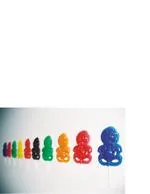The recent art of Wayne Youle
Written by

Wayne Youle (Nga Puhi, Ngati Whakaeke, Pakeha), a young artist whose art playfully explores New Zealand's cultural politics and race relations, has been attracting a lot of attention recently. The representation of Maori culture, both throughout history and in contemporary art and popular culture, is a central subject of investigation in his work.
by Sarah Farrar
Image: Often Liked, Occasionally Beaten (2003)
Courtesy of LINO Magazine - Australia & New Zealand's Premier Lifestyle Magazine
Design Architecture Food Photography Fashion Art Travel Mixedmedia
Check them out at www.linomagazine.com.auWayne Youle (Nga Puhi, Ngati Whakaeke, Pakeha), a young artist whose art playfully explores New Zealand's cultural politics and race relations, has been attracting a lot of attention recently. The representation of Maori culture, both throughout history and in contemporary art and popular culture, is a central subject of investigation in his work.
by Sarah Farrar
Image: Often Liked, Occasionally Beaten (2003)
Courtesy of LINO Magazine - Australia & New Zealand's Premier Lifestyle Magazine
Design Architecture Food Photography Fashion Art Travel Mixedmedia
Check them out at www.linomagazine.com.au"Race, religion, kiwiana, politics, struggle, humour... I find inspiration from so many things. If you treat it with the integrity it deserves, I believe that nothing should be untouchable for an artist," he says. Youle, who grew up in Titahi Bay, studied at the Wellington Polytechnic School of Design and graduated in 1999. In the near future he intends to begin his Masters in Fine Arts, although he says "getting my first solo show underway is priority number one for me right now." ...andthentherewas Wayne " "
Youle is part of a new generation of Maori artists that has been dubbed He Kahui Whetu Hou (a new constellation) by art historian Jonathan Mane-Wheoki. The group, also identified as Te Ringa Hou (recent talent) by curator Ngahiraka Mason, includes Reuben Patterson, Darryn George, Eugene Hansen, Nathan Pohio, Rachel Rakena, Hemi McGregor, Saffron Te Ratana and Star Gossage - and Youle. These artists are seen to be creating exciting and vibrant art that frequently blends aspects of popular culture with mythology and historical or political commentary. In the four years Youle has been exhibiting in Wellington, he has been included in key public gallery exhibitions including the major exhibition of contemporary Maori art, TechnoMaori: Maori art in the digital age, at City Gallery, Wellington; Pataka Museum of Arts and Cultures, Porirua (2001-02) and Koru and Kowhaiwhai at Pataka (2002). He has also had solo exhibitions at public galleries such as his Ratedexhibition at the Michael Hirschfeld Gallery (2001) and Welcome to Maorilandat Pataka Museum (2002).
In February 2004 he had his first solo commercial exhibition Pretty Boy at Bartley Nees Gallery in Wellington. For this exhibition he developed three major new bodies of work. The first body of work is a suite of multicoloured resin tiki lollipops called Often Liked, Occasionally Beaten. This work was inspired by, and made in response to, the blatant use of Maori art forms in tourism, and elsewhere, to express a sense of New Zealand identity as something exotic and different. "I wonder at times how far New Zealand will go in promoting itself," says Youle. "I used to go to Rotorua to be hilariously inspired, but now that I have moved to Christchurch I don't need Rotovegas anymore as I have more than enough fodder here with souvenir stores full of tiki carved off-shore, t-shirts with Ta Moko on the front and postcards with Maori men wearing marker pen moko."
The tiki lollipops are alluring with their bright colours and glossy finish. Miss Thang is another new work which continues this interest in the promotion of Maori identity within New Zealand and overseas. Years ago, Youle recalls seeing a Miss World contest on television in which the current Miss New Zealand, a Pakeha, came out in the national costume section wearing headband, piu piu, taniko, even poi. "I remember her shaking her hips 'island style' and shaking her beautifully manicured hands in an obvious and rather ugly rendition of a Maori dance performance."
For Youle, seeing this brought into contrast the idealised representation of Maori women with the harsh reality that some live. The sash works are "a piss take of beauty, rewards and ideals" that govern the way in which achievement is recognised. At the same time, the sashes pay tribute to all the unsung beautiful people who live in the small towns listed on the sashes whose stories do not often receive attention and celebration.
Youle's third new work Twelve Shades of Bullshit explores the historical representation of Maori in New Zealand art. Twelve silhouettes have been created from illustrations of Maori by early European explorers and artists including Sydney Parkinson (who travelled with James Cook) and George French Angus. Youle discovered that "when traced and reverted into a simple outline, the forms not only change gender, but ethnicity also, with 'whiteman' noses, jawbones and foreheads." He was intrigued by how this process revealed more about the way in which Europeans thought of Maori, than about Maori people themselves.
The silhouettes have been painted in twelve different shades of brown, from a light tan to a dark brown, referencing the various skin tones of contemporary Maori after 160 years of intermarriage with other cultures. Youle's art is characterised by an ongoing cheekiness and a playful investigation of some of the harder issues concerning New Zealand's identity. Humour is refreshingly close to the surface, as he says: "you have to laugh at yourself, otherwise other people will do it for you." Find out more about Wayne Youle's work: www.bartleyneesgallery.co.nz